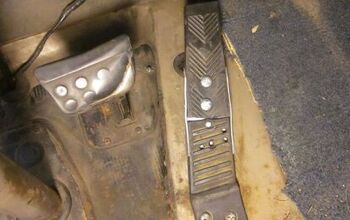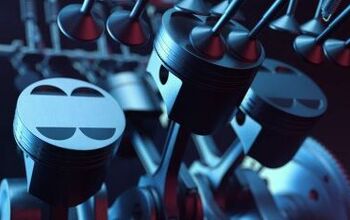Fixing A Hole
May’s new car sales numbers are in and things are looking bleak for The Big 2.8. Their corporate Spinmeisters can blame a down economy and sky-high gas prices all they like, but sales drops well into the double digits are never good news. Market share declines aren’t exactly glad tidings, either. That said, truth be told, Black Tuesday is actually a good sign. It shows that the domestic automakers have finally “accepted” the market. Whether they’re too late is another question entirely.
I repeat: the domestics’ massive sales drops are a good sign, not a good thing. The car market has been “overheated” for at least the last six years. Chrysler, Ford and GM have all been pushing easy credit, “Toe Tag Sales,” “employee pricing” and the like all year, every year. Compounding this "stack 'em high and sell 'em cheap" mentality, they dumped umpteen million extra vehicles onto fleets. “Move the metal” was their immutable mantra.
All this discounting “pulled forward” hundreds of thousands, even millions of sales. People used to buying a new car every five years were “trading up” after three. “Ten year” customers were buying in after five. Metal was moved but little or no profits were banked (all those discounts) and a lot of potential buyers were left completely “upside down” (all those fleet sales cratering resale value).
If The Big 2.8 were ever going to sell anything other than light trucks at a profit, they had to let the market “come up for air.” At the same time, they need time to re-tool to build more of the cars– yes, cars– people were bound– yes, bound– to want. And there’s another important reason why they had to ease off the throttle: financing.
Back when the U.S. auto industry was riding high, the domestics’ pet finance companies booked massive profits. Part of this was down to simple structure; a financing unit is little more than a bunch of computers, a phone center or two and a [relatively] small work force, most of whom make a lot less than assembly workers. With that kind of overhead, even fairly small margins can add up quickly. Given the sort of volume The 2.8 can move, those margins multiplied into the stratosphere.
Sinking sales means fewer loans. So The Big 2.8 bled the finance unit (easy terms and low rates) to prop-up manufacturing. It was an excellent strategy– for going broke twice as fast. Now that credit has been tightened (dodgy loans coming home to roost and all that), the finance arms can finally get on a firmer footing. In fact, sales and profits should return if not rise when the “fire-sale” customers’ cars wear out. This could take a couple of years and would seem to hurt the dealers– but not as much as you might think.
Dealers are conflicted. On one hand, they’re selling fewer cars. Generally speaking, they still make SOME profit, no matter what the discount. So volume is important. On the other hand, they are three to four months (minimum) behind the manufacturers curve on product lines. That’s a fancy way of saying they have a shit load of trucks and SUVs on their lots. Dealers need time to clear space and change their mix. But more importantly, they need to decide whether they want to stick it out at the reduced sales volumes.
For the manufacturers, toughing-out dealers is a major problem. Not because the dealers want to stay in business at any cost. Because they want the best pay-off to get out. The Big 2.8’s dealer deadwood are like holdout tenants in an apartment going condo (or UAW workers looking for a buyout). The longer they wait, they nastier it gets. But the longer they wait, the more they’ll get for leaving.
Bottom line: these sales drops are more of a symptom than a cause. The Big 2.8’s collective collapse is not causing them to finally face reality. The drop is the result of them finally facing reality and giving-up most of their number inflators.
Fifty years ago, GM had over 50 percent of the entire US market. As of May, the collective 2.8 don’t even hold that much. While that's still a huge slice of pie to bake (about 7.5m cars a year), it’s far below their production capacity. Until Detroit– and by that I mean their ops in Canada, Mexico, Australia, Belgium as well– get their production and model mix in line with the REAL market is (not where they’d like it to be), profits will be… elusive. Meanwhile, there's only one possible way for Detroit to recover market lost share: if and when one of them goes belly-up.
There is an oft-quoted British proverb: “if you find yourself in a hole, stop digging.” We can’t be sure if this is the bottom. As bad as it looks, at least the boys from Detroit have stopped digging– about two years late.
More by Andrew Dederer
Latest Car Reviews
Read moreLatest Product Reviews
Read moreRecent Comments
- El scotto They should be supping with a very, very long spoon.
- El scotto [list=1][*]Please make an EV that's not butt-ugly. Not Jaguar gorgeous but Buick handsome will do.[/*][*] For all the golf cart dudes: A Tesla S in Plaid mode will be the fastest ride you'll ever take.[/*][*]We have actual EV owners posting on here. Just calmly stated facts and real world experience. This always seems to bring out those who would argue math.[/*][/list=1]For some people an EV will never do, too far out in the country, taking trips where an EV will need recharged, etc. If you own a home and can charge overnight an EV makes perfect sense. You're refueling while you're sleeping.My condo association is allowing owners to install chargers. You have to pay all of the owners of the parking spaces the new electric service will cross. Suggested fee is 100$ and the one getting a charger pays all the legal and filing fees. I held out for a bottle of 30 year old single malt.Perhaps high end apartments will feature reserved parking spaces with chargers in the future. Until then non home owners are relying on public charge and one of my neighbors is in IT and he charges at work. It's call a perk.I don't see company owned delivery vehicles that are EV's. The USPS and the smiley boxes should be the 1st to do this. Nor are any of our mega car dealerships doing this and but of course advertising this fact.I think a great many of the EV haters haven't came to the self-actualization that no one really cares what you drive. I can respect and appreciate what you drive but if I was pushed to answer, no I really don't care what you drive. Before everyone goes into umbrage over my last sentence, I still like cars. Especially yours.I have heated tiles in my bathroom and my kitchen. The two places you're most likely to be barefoot. An EV may fall into to the one less thing to mess with for many people.Macallan for those who were wondering.
- EBFlex The way things look in the next 5-10 years no. There are no breakthroughs in battery technology coming, the charging infrastructure is essentially nonexistent, and the price of entry is still way too high.As soon as an EV can meet the bar set by ICE in range, refueling times, and price it will take off.
- Jalop1991 Way to bury the lead. "Toyota to offer two EVs in the states"!
- Jalop1991 I'm sorry, Dave. I'm afraid I can't do that.


































Comments
Join the conversation
garythepowers : June 5th, 2008 at 7:11 pm When I read the title of article I thought it was about a handyman who was a real jerk. Heh heh, Since the hard times hit me back in '86, that's been my survival strategy. Buy used or get free, repair, improvise, and make do. About the only thing I buy new is food.
"the beast defuncts being choken by higly organized quatropods and their unremmitting bites of quality, diversity and adaptation skills." That was beautiful, insightful.